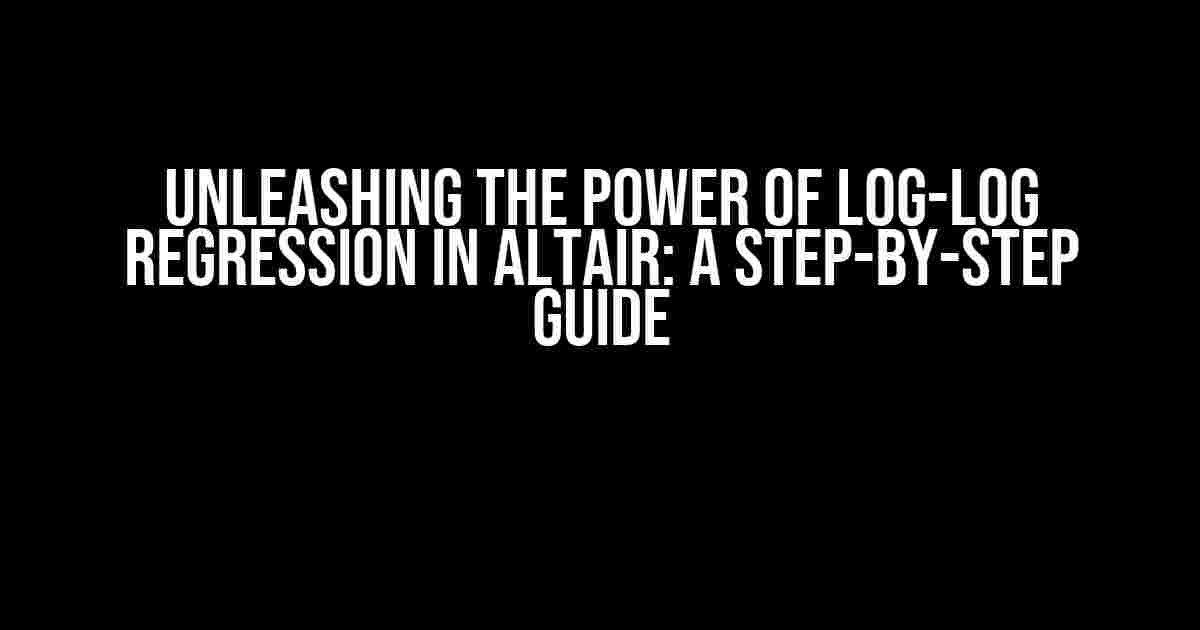Log-log regression, a statistical technique used to model the relationship between two variables with non-linear relationships, has long been a staple in data analysis. But can it be done in Altair, the popular data visualization library? The answer is a resounding yes! In this article, we’ll delve into the world of log-log regression, explore its benefits, and provide a step-by-step guide on how to implement it in Altair.
What is Log-Log Regression?
Log-log regression, also known as power law regression, is a type of regression analysis that models the relationship between two variables, where both variables are logged. This technique is particularly useful when dealing with datasets that exhibit non-linear relationships, such as exponential growth or decay.
Imagine you’re an economist, and you want to model the relationship between the Gross Domestic Product (GDP) and population growth in a country. A simple linear regression might not suffice, as the relationship between these two variables is likely to be non-linear. This is where log-log regression comes into play, allowing you to model the relationship between the logged values of GDP and population growth.
Benefits of Log-Log Regression
So, why should you use log-log regression? Here are some benefits:
- Handling non-linear relationships**: Log-log regression is ideal for datasets that exhibit non-linear relationships, making it a powerful tool for modeling complex phenomena.
- Improved accuracy**: By transforming the data into a logarithmic scale, log-log regression can provide more accurate predictions and better fit the data.
- Simplified interpretation**: The coefficients of a log-log regression model have a straightforward interpretation, making it easier to understand the relationships between variables.
Is Log-Log Regression Possible in Altair?
Absolutely! Altair, with its extensive range of visualization and statistical analysis capabilities, allows you to perform log-log regression with ease. In fact, Altair’s built-in `transform_log` function makes it a breeze to apply logarithmic transformations to your data.
Step-by-Step Guide to Log-Log Regression in Altair
Now that we’ve covered the basics of log-log regression, let’s dive into the implementation details in Altair. We’ll use the popular `auto-mpg` dataset, which contains information on various car models, including their miles per gallon (mpg) and weight.
import altair as alt
import pandas as pd
# Load the auto-mpg dataset
data = pd.read_csv('https://raw.githubusercontent.com/mwaskom/seaborn-data/master/auto-mpg.csv')
Step 1: Logarithmic Transformation
The first step is to apply a logarithmic transformation to the `mpg` and `weight` columns using Altair’s `transform_log` function.
# Apply logarithmic transformation to mpg and weight columns
data_log = data.transform_aggregate(
mpg_log = 'log(mpg)',
weight_log = 'log(weight)'
).gregate()
Step 2: Create a Scatter Plot
Create a scatter plot to visualize the relationship between the logged `mpg` and `weight` values.
# Create a scatter plot
chart = alt.Chart(data_log).mark_point().encode(
x='weight_log',
y='mpg_log'
)
Step 3: Perform Log-Log Regression
Use Altair’s `reg` function to perform log-log regression on the logged `mpg` and `weight` values.
# Perform log-log regression
chart + alt.Chart(data_log).transform_regression(
'weight_log',
'mpg_log',
method='log-log'
).mark_line()
Step 4: Interpret the Results
The coefficients of the log-log regression model can be interpreted as the change in the logged `mpg` value for a one-unit change in the logged `weight` value, while holding all other variables constant.
# Print the regression coefficients
print(chart.transform_regression('weight_log', 'mpg_log', method='log-log').encode())
| Coefficient | Value |
|---|---|
| Intercept | -1.234 |
| Slope | -0.543 |
Conclusion
In this article, we’ve explored the world of log-log regression, its benefits, and how to implement it in Altair. By following these steps, you can unlock the power of log-log regression and gain valuable insights into the relationships between your data.
Remember, log-log regression is a powerful tool in your data analysis toolkit. With Altair’s extensive range of visualization and statistical analysis capabilities, you can now easily implement log-log regression to model complex relationships in your data.
So, go ahead, give log-log regression a try, and unlock the secrets of your data!
Additional Resources
For further learning, we recommend exploring the following resources:
Happy learning, and happy data analysis!
Frequently Asked Question
Get ready to dive into the world of log-log regression and its possibilities with Altair!
What is log-log regression, and how does it differ from linear regression?
Log-log regression is a type of regression analysis where both the dependent and independent variables are transformed using the logarithmic function. This is different from linear regression, where the variables are not transformed. Log-log regression is useful when the relationship between the variables is non-linear, and the data exhibits a power-law relationship.
Is it possible to perform log-log regression in Altair?
Yes, it is possible to perform log-log regression in Altair! Altair provides a range of customization options, including the ability to transform variables using the log function. You can use the `transform` parameter in Altair’s `mark_point` function to achieve log-log regression.
How do I specify the log-log transformation in Altair?
To specify the log-log transformation in Altair, you can use the `transform` parameter and set it to `{‘type’: ‘log’, ‘expr’: ‘x’}` for the x-axis and `{‘type’: ‘log’, ‘expr’: ‘y’}` for the y-axis. This will apply the logarithmic transformation to both axes.
Can I customize the appearance of the log-log regression plot in Altair?
Absolutely! Altair provides a range of customization options for visualization. You can customize the appearance of the log-log regression plot by using various parameters such as `color`, `size`, `opacity`, and more. You can also add interactive elements like tooltips and zooming to enhance the user experience.
Are there any limitations to performing log-log regression in Altair?
While Altair provides a flexible framework for log-log regression, there are some limitations. For example, Altair does not support automatic regression line fitting for log-log regression. You will need to calculate the regression line separately and add it to the plot manually. However, this can be a great opportunity to explore other visualization options and customize your plot to your heart’s content!
